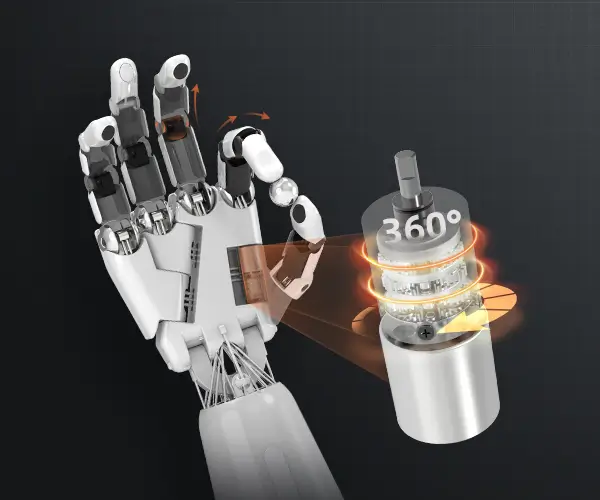Unlocking Precision: The Power of RC Servo Motors with Feedback
In the realm of robotics, automation, and high-performance hobbyist projects, precision control isn’t just a bonus—it’s a necessity. Whether you’re steering a robotic arm, crafting a drone, or fine-tuning a remote-controlled car, the ability to achieve exact positioning and smooth motion is critical. Enter the RC servo motor with feedback, an unsung hero that takes traditional servo technology and elevates it to new levels of accuracy, reliability, and adaptability.

What is an RC Servo Motor?
At its core, an RC (radio control) servo motor is a compact actuator designed to provide precise rotational or linear movement based on a control signal. It’s the backbone of countless remote-controlled devices, from model airplanes and cars to industrial automation systems. These devices use servo motors because of their straightforward control interface and remarkable positional precision.
Typical RC servo motors consist of a small DC motor, a set of gears, and a control circuit. The control circuit interprets a PWM (Pulse Width Modulation) signal to determine the desired position of the servo arm. The motor then turns until the potentiometer (or another feedback device) indicates that the shaft has reached that position, closing a control loop that maintains the position until instructed otherwise.
Feedback in Servo Motors: What and Why
Traditional RC servo motors are closed-loop systems, but their feedback mechanisms are often simplistic. They typically rely on a potentiometer connected to the motor shaft for position sensing. This feedback allows the servo to compare the current position with the commanded position and adjust the motor accordingly. However, advancements have introduced more sophisticated feedback systems to improve accuracy and performance—hence the rise of "RC servo motors with feedback."
Feedback mechanisms essentially serve as the "sense organs" of the servo system. They continuously monitor the motor's actual position, speed, or torque and relay this information back to the control circuit. In high-end servo systems, this can include encoders, resolvers, or even strain gauges, each offering different levels of detail and robustness.
Why Is Feedback Important?
The inclusion of feedback significantly enhances the servo’s capabilities:
Precision and Accuracy: Feedback allows the servo to correct for any positional errors, ensuring the motor reaches the exact desired point—even in complex or dynamic environments. Stability and Reliability: Continuous feedback reduces jitter and oscillations, leading to smoother motion—a must in delicate operations like robotic surgery or camera stabilization. Handling Load Changes: When motors encounter varying loads, feedback helps maintain position despite external forces, ensuring consistent performance. Advanced Control Strategies: Feedback enables implementation of sophisticated algorithms such as PID (Proportional-Integral-Derivative) control, which further refine motion control for fast, precise responses.
Applications of RC Servo Motors with Feedback
The scope of RC servo motors with feedback extends far beyond simple hobbyist projects. Their precision and adaptability have made them crucial components in industries and applications including:
Robotics: From humanoid robots to automated manufacturing arms, feedback-enhanced servos ensure exact movements, repeatability, and stability. Aerospace and Drones: Precise control over flight surfaces and camera gimbals depends heavily on feedback systems to adapt to turbulence and maintain stability. Medical Devices: High-precision servos are vital in surgical robots, where accurate, smooth movements can be lifesaving. Camera and Telescope Mounts: For astrophotography or cinematic automation, feedback-enabled servos help achieve pinpoint positioning and tracking. Advanced Hobby Projects: Technologists and enthusiasts experiment with feedback systems for self-balancing robots, CNC machines, or robotic arms—pushing the boundaries of what hobbyist electronics can achieve.
Types of Feedback Devices in RC Servo Systems
While traditional servos rely on potentiometers, the evolution of feedback technology has introduced various sensors to enhance performance:
Potentiometers: Still the most common in standard RC servos, offering simplicity and affordability but limited precision and durability over time. Encoders: Used in high-end systems; they provide digital position feedback with higher resolution and robustness, especially optical and magnetic encoders. Resolvers: Analog devices offering high accuracy and durability underExtreme conditions, used in aerospace or military-grade applications. Strain Gauges and Torque Sensors: These are less common but provide real-time data on load and torque, ideal for applications where force feedback is crucial.
Evolution of RC Servo with Feedback
The traditional servo, primarily relying on potentiometers, served well for hobby applications. Yet, as demands for accuracy, durability, and integrated intelligence grew, manufacturers started embedding advanced sensors and control electronics. Modern feedback-enabled servo motors often incorporate microcontrollers or DSPs (Digital Signal Processors), enabling on-board data processing, calibration, and even diagnostic capabilities.
Such integration allows for features like:
Auto-calibration for consistent performance over time. Error diagnostics to alert users to mechanical wear or faults. Integration with other automation systems via communication protocols like CAN bus, UART, or EtherCAT.
The transition from simple potentiometer-based feedback to high-resolution encoders and sophisticated control algorithms marks a significant leap forward in servo motor technology. It transforms a basic positioning device into a smart actuator capable of complex, real-time decision-making, laying the groundwork for more autonomous and intelligent systems.
Established in 2005, Kpower has been dedicated to a professional compact motion unit manufacturer, headquartered in Dongguan, Guangdong Province, China.




































